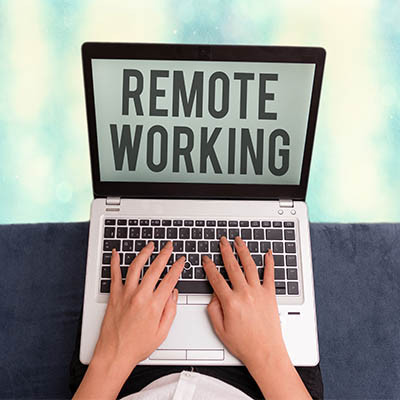Ferrum Technology Services Blog
Remote work has presented considerable challenges for employers and businesses around the world, and while many of these challenges are still present, some have been resolved through the use of hybrid work accommodations. This strategy allows companies to provide flexibility to employees while still retaining the advantages of in-office work.
Ever since the pandemic, there has been an increased focus on mental health and well-being in the workplace. This has led many business owners to consider how they can improve their employees’ relationships with not just each other, but all of the other important people in their lives. As it turns out, remote work can be a major facilitator in this effort.
How has your business responded to the pandemic? Were you one of the companies who struggled to make remote operations a reality, and if so, are you currently one of the companies resistant to allowing for remote work moving forward? Make no mistake, remote policies are something which your business should be prepared to address, be it in the form of a hybrid workplace or a fully remote one. Let’s explore your options.
It doesn’t really matter what your stance is on remote work, as it has become quite clear that it is one of the aspects left over from the ongoing pandemic that is unlikely to go anywhere anytime soon. Despite these new developments, however, employers are still demanding that employees return to the office, a prospect which some do not take kindly to. How can you ask your employees to return to the office while also making it worth their while to do so?
What are some of the modern challenges that your business struggles with? Maybe it’s technology management or maybe it’s network security. According to the GDPI 2021 survey issued by Dell, certain trends are overwhelmingly dangerous for countless businesses out there. Let’s take a look at the results of the 2021 survey and what they might mean for your business.
With today’s ever-expanding remote workforce, there is all the more reason to implement technology solutions that empower your organization to increase its range of options for working outside of the office. We’ve put together three of the key technology solutions we think your organization could benefit from to improve its remote capabilities and take business on the road.
Many workplaces have taken to fighting the pandemic by adjusting their workplace strategies to enable both in-person and remote work. This change occurs as many companies realize that remote work is indeed a viable option, even in industries that have traditionally been opposed to the concept. With remote work so commonplace, it’s only prudent to include it in the onboarding process. Let’s go over some ways you can encourage your employees to build a more productive home office situation.
Remote work for certain types of positions has really become quite popular, but for others, this is not necessarily true. For example, knowledge workers are seeing fewer new job postings. According to a report from Braintrust analyzing 150,000 new job postings, things are not all well and good for remote work.
When the COVID-19 pandemic started to surge across the world, much of the workforce shifted to remote operations, but it has become clear over the past several months that this shift is likely temporary, forcing many employers to consider the hardest question of all: what will it take to get people back in the office? A report from Gartner suggests that it’s not as easy as it sounds, and in fact might be moving in the opposite direction to what employers are hoping.
Unfortunately, the COVID-19 pandemic is still in full swing, and while many companies buckled under the pressure put on them to maintain operations, others have managed to adapt through the use of remote technology solutions. Businesses have put into place policies surrounding this remote technology, many of which are both helpful and harmful.
It can be hard to look into the future, especially today when that future can often look bleak and unpredictable. It’s incredibly important, however, to do so, especially in the realm of your business’ operations. When the pandemic is over, how are you going to corral your employees back to your office? Are you even going to attempt this? Perhaps, now more than ever, it’s time to reevaluate your operational infrastructure and how technology can impact it.
As COVID-19 vaccines keep rolling out, there is a big question of what’s next for the modern small business. How are businesses going to operate once it is relatively safe to go back to the workplace? This month we thought we’d briefly discuss the issue of creating a hybrid work model and how in the world businesses are going to manage it.
When the pandemic hit early in 2020, many business owners didn’t understand the situation they were about to face. Many businesses didn’t have the technology in place to support remote work, and the ones that did likely had employees that weren’t prepared for the responsibilities that come with working from home. Now, as millions of people are getting vaccinated and governments are slowly lifting restrictions, the question becomes: What now?
Lots of things have been scaled back in 2020, but one thing that hasn’t is the presence of the remote worker. Outside of the normal amount of people that work from home, the COVID-19 pandemic has created opportunities for people who typically didn’t get the chance to do so to work from the comfort of their own homes. Let’s take a look at a few gadgets that have to be a part of every remote worker’s home office.
As so many businesses have had to close their doors recently, remote work has become a very popular option. Unfortunately, this sudden shift has not been without negative side-effects. One such byproduct of this shift has been a serious overworking problem. This is a big problem, and one that you need to address if it has presented itself in your operations.
While many businesses right now have found it best for their operations to shift to a remote strategy, it is important to consider how these operations will return in-house when it is again appropriate to do so. For this week’s tip, we’re reviewing a few best practices to help you contend with both processes.
With COVID-19 still in play, working remotely has become how many employees have continued to fulfill their work responsibilities. Now, as we settle into this new way of doing things, the question has arisen: after all this is over, will business operations return to the way they once were? Let’s discuss.
Under the current circumstances, remote work is being viewed as the safer option. This has led a lot of businesses to adopt these practices for the time being--you may have already done so. However, some employees have a better grasp of how to properly work from home than others. We’ve put together a few examples of how an employee may conduct themselves while working from home.



















